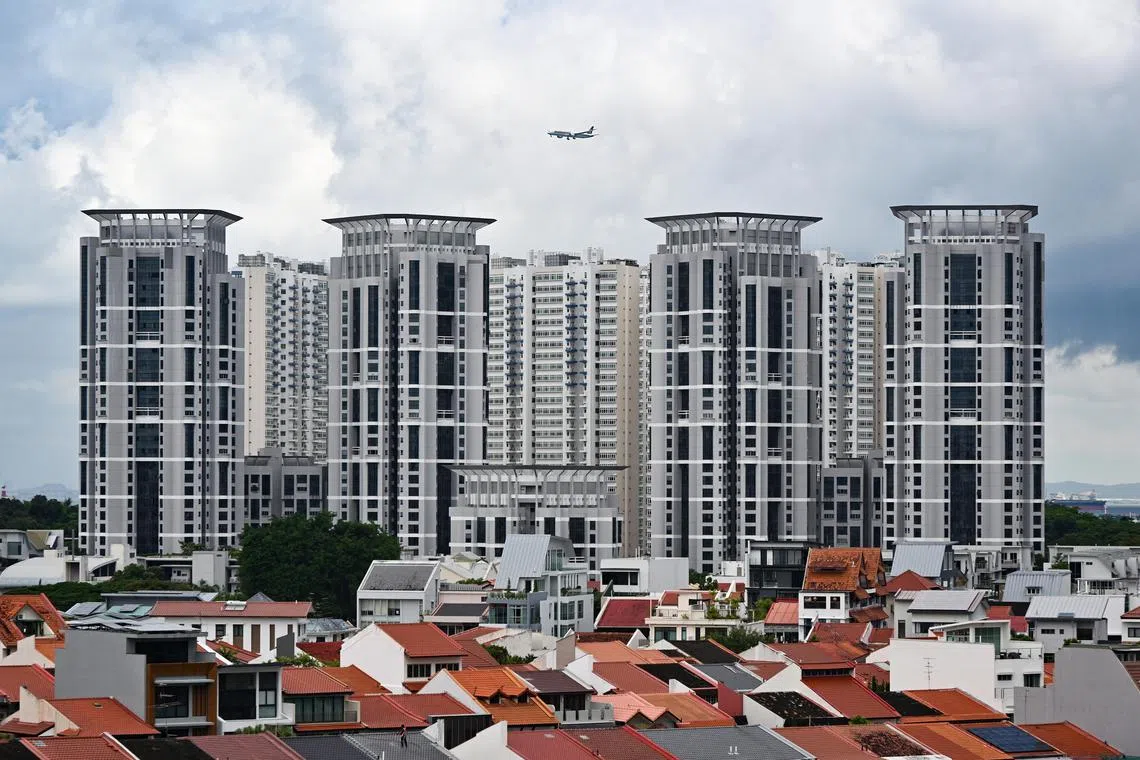Private home price growth continues to slow in Q2 2025
Sign up now: Get ST's newsletters delivered to your inbox

Flash estimates show that the private residential property price index grew by 0.5 per cent in the second quarter of 2025 over the previous quarter.
ST PHOTO: LIM YAOHUI
Follow topic:
SINGAPORE – The growth in private residential property prices continued to lose momentum in the second quarter of 2025, according to flash estimates released by the Urban Redevelopment Authority (URA) on July 1.
The private residential property price index rose by 0.5 per cent in the second quarter, compared with the 0.8 per cent growth in the first quarter
“In line with the decline in the number of units launched for sale, sale transaction volume fell by about 40 per cent on a quarter-on-quarter basis in (the second quarter of) 2025,” said URA.
There were 4,340 private homes sold in the second quarter, compared with 7,261 in the previous quarter.
Across all areas in Singapore, prices of non-landed properties increased by 0.5 per cent in the second quarter, after a 1 per cent rise in the previous quarter.
However, the price movements were mixed across regions.
In the core central region, prices of non-landed properties increased by 2.3 per cent, picking up from a 0.8 per cent gain previously.
Elsewhere in the central region, non-landed property prices dropped by 1.1 per cent, reversing a 1.7 per cent growth in the previous quarter.
Outside the central region, prices of non-landed homes increased by 0.9 per cent, compared with a 0.3 per cent increase previously.
As for landed properties, prices rose by 0.7 per cent, up from a 0.4 per cent gain in the first quarter.
Property analysts largely attributed the slowdown in price growth to fewer new launches in the second quarter of the year, compared with the first quarter.
This was due to the general election period in April and May, as well as the school holidays in June, said ERA Singapore chief executive Marcus Chu.
Mr Mohan Sandrasegeran, head of research and data analytics at Singapore Realtors Inc, said that headwinds from American tariffs have also caused developers to refrain from launching new projects in recent months.
“Developers were likely waiting out short-term uncertainties and positioning themselves for more favourable market conditions in the second half of the year,” he added.
Mr Leonard Tay, head of research at Knight Frank Singapore, said buyers have also been affected by the global uncertainties, with more taking a “watch-and-wait” approach in recent months.

Ms Christine Sun, chief researcher and strategist at Realion Group, said buyers are likely to remain cautious in the months to come, due to tensions in the Middle East and global trade uncertainties.
She noted, however, that with interest rates projected to fall for the rest of 2025, homes will become more affordable.
“The sustained interest rate drops and lower cost of borrowing will create a more favourable buying environment, especially for first-time home buyers and investors with tighter budgets,” she said.
Despite the global uncertainties, Mr Mohan expects the private residential market to remain resilient in the second half of the year.
He attributed this to a slate of upcoming project launches that could ride on the buzz surrounding the URA’s Draft Master Plan 2025, which was launched on June 25.
The plan lists areas where new homes and amenities will be developed, such as in Newton and Paterson, which will both be used for private housing.
Mr Nicholas Mak, chief research officer at Mogul.sg, said one silver lining in the slower price growth in the second quarter is that more cooling measures are unlikely in the months to come.
Current measures include the 60 per cent additional buyer’s stamp duty that was introduced in April 2023
To meet housing demand and maintain market stability, URA said the Government is sustaining a “high level of private housing supply” in the Government Land Sales programme.
On June 24, URA announced that 4,725 private residential units will be launched in the second half of 2025
On projected trends for 2025 as a whole, Mr Tay said private home prices are likely to stabilise, with growth projected at between 3 per cent and 5 per cent.
Mr Mohan agreed that full-year growth is likely to be moderate, ranging from 3 per cent to 6 per cent. “This outlook reflects a balance of external uncertainties, sustained local demand and calibrated land supply,” he said.


